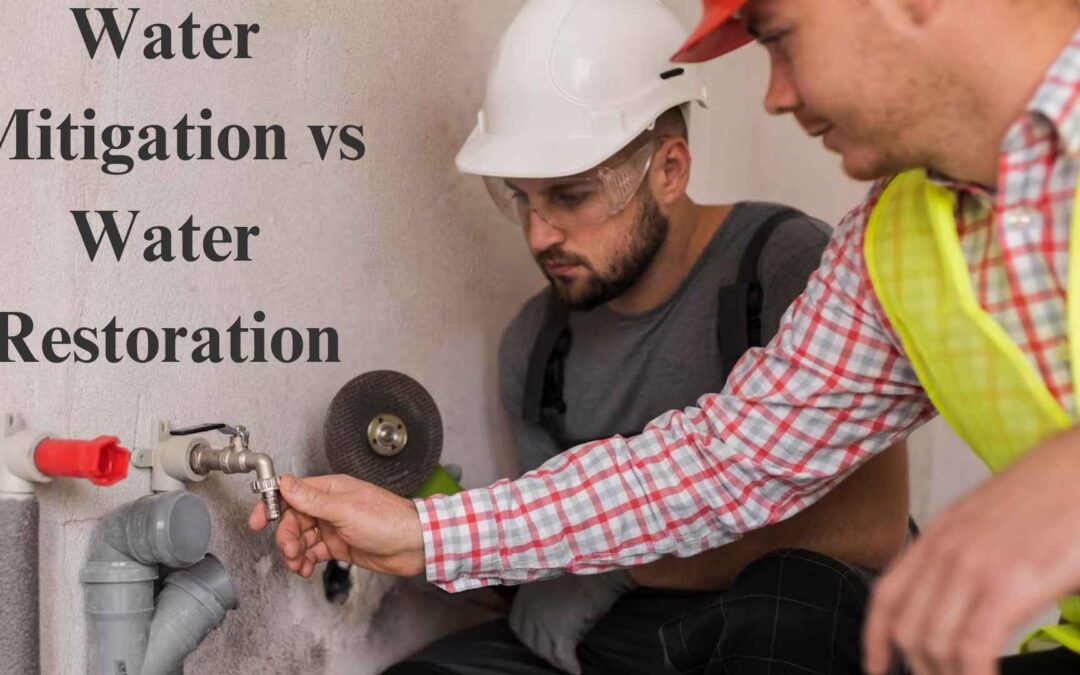Water Mitigation vs Water Restoration: When your home or business experiences water damage, two key terms often come up during the recovery process: water mitigation and water restoration. While these terms are sometimes used interchangeably, they refer to different stages in the water damage recovery process. Understanding the distinction between the two can help you make informed decisions when water damage strikes.
What Is Water Mitigation?
Water mitigation refers to the initial efforts made to reduce the severity of water damage. The goal is to prevent further damage to the property after events like a flood, leak, or burst pipe. During this process, professionals act quickly to remove standing water, dry affected areas, and stop water from spreading to other parts of the property.
Key Steps in Water Mitigation:
- Water Removal: Using industrial pumps and vacuums, standing water is extracted to prevent additional damage.
- Damage Prevention: Wet items, such as furniture, carpets, and valuables, are removed to minimize further destruction.
- Drying and Dehumidifying: Air movers and dehumidifiers are used to dry the property and reduce moisture levels, preventing mold growth.
- Temporary Repairs: Measures like boarding up windows, applying tarps, and reinforcing walls are taken to prevent further exposure to water damage.
The goal of Water Mitigation
The primary aim of water mitigation is to control the spread of water and limit further damage to the structure. It’s a short-term solution focused on containing the problem.
What Is Water Restoration?
Once the water mitigation phase is complete, water restoration begins. Water restoration focuses on returning the property to its pre-damaged state. This phase includes repairs, replacements, and deep cleaning of affected areas. Water restoration goes beyond damage control and involves rebuilding and recovering the property.
Key Steps in Water Restoration:
- Repairing Damaged Areas: Walls, ceilings, and floors affected by water damage are repaired or replaced as necessary.
- Cleaning and Sanitizing: Water-damaged areas are thoroughly cleaned and disinfected to remove harmful bacteria, mold, and other contaminants.
- Restoring Contents: Items such as furniture, electronics, and personal belongings may be restored or replaced depending on the extent of the damage.
- Final Inspections: The area is inspected to ensure that all repairs and restorations have been completed and the property is safe to use.
Goal of Water Restoration
The focus of water restoration is to return the property to its original condition or better. It’s a long-term solution aimed at full recovery.
Water Mitigation vs Water Restoration Key Differences
| Aspect | Water Mitigation | Water Restoration |
|---|---|---|
| Timing | Immediate action, often during or right after the water damage | Occurs after mitigation, focused on long-term recovery |
| Purpose | Prevent further damage | Restore the property to its pre-damaged state |
| Focus | Short-term, damage containment | Long-term, property restoration |
| Process | Water extraction, drying, and prevention | Repairs, cleaning, and rebuilding |
| Goal | Minimize water impact and stop damage | Repair and return to original condition |
| Duration | Typically 1 to 3 days | Could last from several days to weeks, depending on the extent of the damage |
When Is Water Mitigation Needed?
Water mitigation is crucial immediately after water damage has occurred. It’s crucial in cases of:
- Flooding: To prevent water from spreading throughout the property.
- Leaking Roofs: To protect the interior of the building until permanent repairs can be made.
- Sewage Backups: To stop contaminated water from posing further health risks.
- Burst Pipes: To minimize water damage to walls, floors, and ceilings.
When Is Water Restoration Required?
Water restoration is needed once the water mitigation process has been completed and the affected areas are dry. Common situations requiring water restoration include:
- Post-Flood Repairs: After the water has been extracted and the building has dried, restoration services begin.
- Mold Remediation: If mold is detected following water damage, restoration professionals will address the mold problem along with structural repairs.
- Rebuilding Damaged Areas: If parts of the property were significantly damaged, restoration services are essential to rebuild and restore the space.
Which Service Should You Call First?
If you’ve experienced water damage, you need to start with water mitigation services. The priority is to contain the damage and prevent it from getting worse. Once the property is stabilized, water restoration services can begin to bring your property back to its original condition.
Many professional companies, such as Boston Fire and Flood Restoration, offer both water mitigation and water restoration services. This means you can rely on one team to handle the entire recovery process from start to finish.
Conclusion
Water mitigation and water restoration are both critical steps in recovering from water damage. Water mitigation stops the damage in its tracks, while water restoration focuses on repairing and rebuilding your property to its pre-damage state. For the best outcome, hire a professional company like Boston Fire and Flood Restoration that specializes in both services to ensure a comprehensive recovery plan.
FAQs of Water Mitigation vs Water Restoration
What is the difference between water mitigation and water restoration?
Water mitigation focuses on preventing further damage after water exposure, such as removing water and drying the area. Water restoration, on the other hand, involves repairing the damage and returning the property to its pre-damaged state. At Boston Fire and Flood Restoration, we specialize in both services to provide a complete recovery.
How long does water mitigation take?
Water mitigation usually takes 1 to 3 days, depending on the severity of the damage. This process focuses on damage control and water removal.
When do I need water restoration?
Water restoration is required after water mitigation has been completed. Once the property is dry, Boston Fire and Flood Restoration begins repairs, cleaning, and rebuilding to restore your home or business.
Can I skip water mitigation and go straight to restoration?
No. Skipping water mitigation can lead to additional damage, mold growth, and unsafe conditions. Water mitigation is essential to stabilize the situation before restoration can begin.
How can Boston Fire and Flood Restoration help me with water damage?
We provide comprehensive water damage restoration in Boston, offering both water mitigation and water restoration services. Our experienced team handles everything from water extraction to final repairs, ensuring your property is restored quickly and safely.
Contact Us
If your property has experienced water damage, don’t wait to act. Contact Boston Fire and Flood Restoration at +1 339-675-1388 or email us at [email protected].
Our professional team is available to provide fast, effective water damage recovery services in Boston. We specialize in water mitigation, water restoration, and fire damage restoration to help restore your property to its pre-damage condition.

